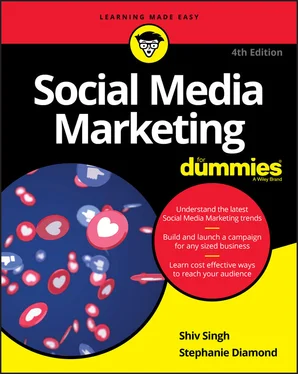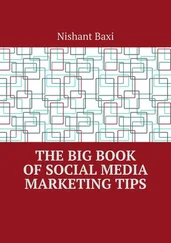1 ...6 7 8 10 11 12 ...22 There’s another side to the story, though. The more data that you can capture about your customers through social media marketing tactics, the more opportunities you have to feed your direct mail database. That’s just a factor of consumers doing more online, sharing more of themselves, and opting into direct mail efforts in exchange for information or acceptance into an online community. Your database may get richer with social media marketing in the mix, but the value of it may decrease — although that doesn’t mean that you can’t use direct mail as a starting point to jump-start an online community, sustain interest in it, or reward participation through mailing coupons. The solution? Think about how you collect information about your consumers differently and, more important, how you share information back to them. It doesn’t have to only be via mail or only via social media; knowing when to use what form of communication is key. More on this in later chapters.
Among the earliest proponents of social media were digital-savvy public relations experts. Many of them entered this space by treating social media just as they have treated the mainstream media. These professionals equated buzz (how much people talk about a specific product or brand) in the social media realm with press mentions in the mainstream media. These PR experts identified the influential ( influence defined as those having the most reach) bloggers and tweeters and started showering them with the same kind of attention that they had been bestowing on the mainstream media. They sent them press releases in advance, offered exclusive interviews, invited them to dinners, commented on their blogs, and carefully tracked how much their brands were mentioned and how positively.
For PR professionals, this approach made perfect sense. Arguably, they recognized early on how powerful social media could be and were among the first to track brand mentions and participate in conversations. In fact, many of the social media experts today are former public relations professionals who’ve taken the time to understand how social media works and how they can leverage it to support a company’s or a brand’s objectives. Many PR professionals also understand how bad press and traditional PR disasters can be amplified by social media if not addressed immediately.
But life isn’t that simple, and the relationship between public relations and social media is a complex one — which is something that the savviest of PR professionals understand and have always understood. Public relations is fundamentally about managing the press (mainstream or alternative) and pushing a company’s communications agenda out to the world as much as possible. Whether it’s the mainstream or alternative media, it doesn’t matter. From a public relations professional’s perspective, the press is the press, and they’re only as good as their ability to amplify a company’s message. That’s where the problem lies.
When we look at marketing and how it harnesses social media, some of its core tenets are in conflict with public relations. For example, social media marketing is about social influencers influencing each other through social media. The focus is on the social influencers influencing each other and not on the PR professionals influencing people in the social media realm. The difference is that as consumers, we’re trusting and depending upon each other more for advice than on large corporations. The PR professionals, for all their sincerity and skill, will still push a company’s message as forcefully as they can — and in that, it conflicts with social media marketing. But still, here’s something extremely important to consider: The more forward-looking public relations experts approach PR from a broader communications perspective and have taken the time and energy to understand the space deeply. Those who do that are much better equipped to understand and market through social media than other professionals.
Is there a remedy for conflicts between departments? Not necessarily, but as you deploy social media marketing campaigns, be sensitive to the fact that your goals and aspirations may be in conflict with your PR organization if it hasn’t embraced social media or social media marketing. Have a conversation with its staff early on, find ways to collaborate and delineate boundaries, too — who does what, who reaches out to whom, and how much space is given to authentic social influencers to do the influencing versus the PR professionals. And as you do this, keep in mind that for many PR professionals, social media marketing is an evolution of PR. That’s a good thing, providing for even more opportunities to collaborate. And, of course, remember that you may have peers in the public relations department who could teach you a thing or two about social media marketing as well!
When it comes to buying online advertising (also referred to as digital media planning and buying) on websites where your customers spend time, social media marketing plays an important role. Online advertising is about identifying websites that your target customers visit, buying ad space on those websites, and then measuring how much those ads are viewed and clicked. It’s as much an art as it is a science because knowing which sites your customers visit, where they’re most likely to engage with an advertisement (where on the site as well), whether the site charges the appropriate amount for the advertisement, and how much that advertising affects purchasing is not always easy. We work with media buyers all the time, and their jobs are harder than you think, especially in the world of digital ad exchanges, data management platforms, and remnant inventory. (Books could be written on each of those terms alone.)
But the online advertising space is important even in an economic downturn. The reason is simple: It’s one of the most measurable forms of advertising, especially in relation to print and television, along with search engine advertising. You can track those who view the advertisement, what they do with it, and in some cases, whether they eventually buy the product based on that advertisement. It’s no surprise that the relationship to social media marketing is an important one as a result.
This relationship with social media marketing takes various forms. Here are some of those connection points:
Market to the social influencers who surround the customer, as well as the customer.One of the ways in which you market to those influencers is using display advertising. So rather than just placing advertisements on websites that your customers visit, you place some advertisements (doesn’t have to be a large percentage of your budget) on websites that their social influencers frequent, too. Is this as measurable as those advertisements targeting your customers directly? Maybe not, because these influencers are less likely to click the ads and make a purchase. But nevertheless, they remember the brand and influence your customers.
Communicate and advertise on the social platforms — such as Facebook and YouTube — that your customers frequent.Most social platforms accept advertising in some form, and this serves as an important part of their revenue model. Figure 1-5 shows an eBay display advertisement on YouTube.Granted, display advertising on social platforms used to produce bad results (users didn’t notice the advertisements and didn’t click them), but the ad formats for social platforms are evolving, and today Facebook is the second-largest advertising platform on the Internet after Google. One example of the evolution, is video-based advertising in the Facebook newsfeed itself. Another innovation that has been honed over the last two years is where consumers are asked to like the ads that they’re viewing on Facebook, resulting in their action appearing more aggressively in the newsfeeds of their friends. This helps the platform target ads more appropriately to them in the future.
Читать дальше












